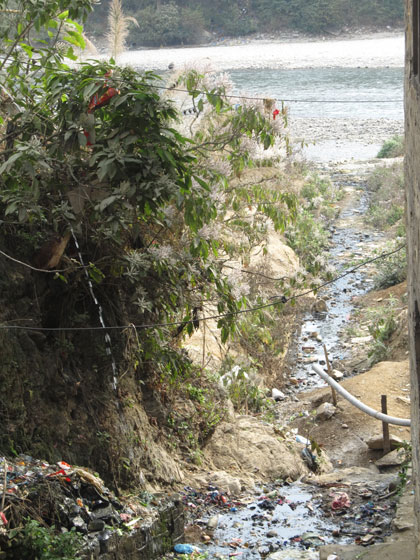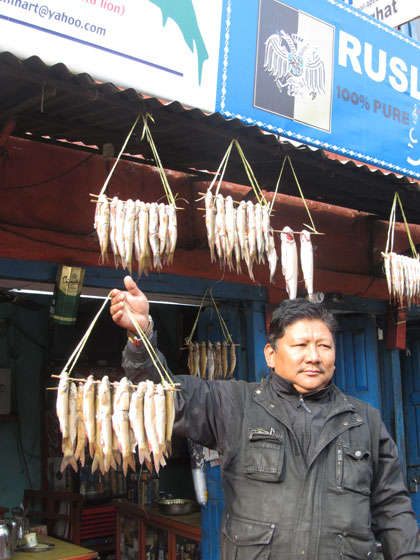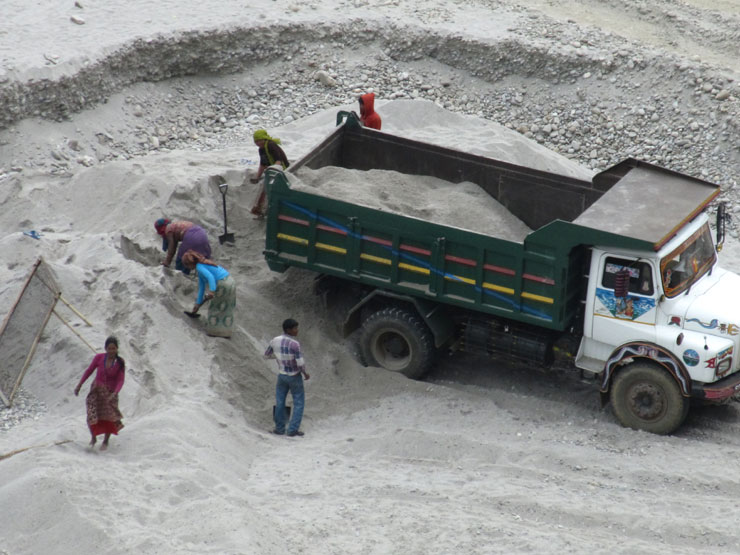Polluted Rivers Worry The Majhi Community
By Sangeetha Rajeesh
19 May, 2013
Countercurrents.org
Fish might form just a minor intake in the overall diet; nonetheless, it is a very important source of protein for a community living in poverty. But, polluted rivers, destructive fishing practices and overfishing has resulted in declining fish stocks posing a threat to the very survival of the Majhi
 Dolalghat, NEPAL - Sete Majhi is 40-years old and fishing is all he knows. He remembers his father and grandfather catching fish in Sun Koshi. “This is our tradition; I don’t know any other work with which I can support my family,” he admits.
Dolalghat, NEPAL - Sete Majhi is 40-years old and fishing is all he knows. He remembers his father and grandfather catching fish in Sun Koshi. “This is our tradition; I don’t know any other work with which I can support my family,” he admits.
Sete lives with his wife, three daughters and one son, and also takes care of his brother’s family. “It’s a kind of joint family system, but we have separate kitchens,” he explains. He has had to send his children to a boarding school because he could not provide enough food for the family.
waste water being discharged
into the river and this has
polluted the rivers >>>>>>>>>>>
A dejected fisherman, Sete says, “I don’t know what has happened to the fish!? We used to catch about eight kilos every day, but of late, we hardly catch two kilos.” Sete speaks of the abundance of Asala (a kind of Trout) and Katle (Carp) he used to be able to sell to the local market and still have enough for daily consumption. “I would sell about 90% of my catch for about Nepali Rupees 500 a kilo and keep the rest for family,” he shares.
Steady decline in fish catches from Indravati and Sun Koshi rivers in Dolalghat village, Kavre District, is distressing the Majhi (fishing) community. At Dolalghat, the Indravati River joins Sun Koshi and flows east to the rivers Arun and Tamor, which eventually pass south as Saptakoshi drainage.
 Lama T owns a fish shop bang opposite the Dolalghat police station. “I’ve been in this business for more than 11 years now, and it has never been worse than this!” confirms Lama. He tells us that the supply of fish has dropped by 50% over the last five years. “Because of short supply, I am forced to sell Rainbow Trout at 1000 Nepali Rupees a kilo and Asala, I sell at 800 per kilo, which is at least 200 Nepali Rupees more than usual.”
Lama T owns a fish shop bang opposite the Dolalghat police station. “I’ve been in this business for more than 11 years now, and it has never been worse than this!” confirms Lama. He tells us that the supply of fish has dropped by 50% over the last five years. “Because of short supply, I am forced to sell Rainbow Trout at 1000 Nepali Rupees a kilo and Asala, I sell at 800 per kilo, which is at least 200 Nepali Rupees more than usual.”
<<<<< Lama has been selling fish from 11 years now and has noticed a rapid decrease in supply from the rivers
Lama has always bought all his fish from the Majhi community, but has observed that they bring less and less fish every year. “The Majhi used to bring ten or 12 kilos of fish, now I receive only four or five kilos just every other day.” He brags, “During season time, my shop will be so full of fish that I will sell round the clock for two whole months; that’s why my shop is called ‘Any Time Fish (ATF) shop’!”
Those good days have disappeared, feel Sete and Lama.
Unable to make sufficient money, Sete began to look for any kind of work that can compensate for his drop in fish earnings. “I now work as construction labourer for about ten days a month and get paid Rs 200 ($ 4) every month. I know it is not good money, but at least it is something,” he tries to console himself. Most of the Majhi community have never been to school and find it difficult to find decent employment when the fishing season is over.
“Sete is not an isolated case,” Nani Ram Subedi, Livelihoods and Governance specialist with ICIMOD, Nepal, explains, “With most of the Majhi people below poverty line, their economic status dips further when their livelihood source is contaminated.”
Dilip Majhi is 31-years-old and takes care of his mother and siblings. He hails from Bhumlutar Ward 6 that is populated with 48 Majhi families, and watches as his brother and sister ready their single-use fishing nets. “Do you know that these fish nets take us at least six hours to make?” he says pointing to the nets, “and even after spending all that time and having almost the whole family engaged in making the paso, we end up with barely enough fish to eat.”
Looping, locally called paso, is practised in Sun Kosi Rivers, and is the most common and traditional fishing method used by the Majhi community. A single line may support 3-5 nylon loops and generally, the fisherman sets the paso in the evening and collects his catch early in the morning. The paso is for single-use only and have to be repaired for the next day’s catch. It is used from September to April, when the stream water is clear and cold and the fish start their upstream migration.
“We use the paso so as not to harm the fish, but ever since the Sun Koshi has become a popular destination for water-rafting, there have been other communities staying along the river banks,” Dilip notes, and adds, “These outsiders catch our fish illegally – most of them come at night time and use electricity to catch Asala; others divert the river channel when water levels are low.” He observers, “On many occasions, the settlers on Sun Koshi banks have even poisoned the river waters in a desperate bid to catch Katle!”
Talking of how the Majhi people are dependent on traditional occupation, Shunali, Sete’s wife informs that the families in Dolalghat have always fished freely in Indravati and Sun Koshi rivers for their own nourishment. “But now, the men in the village are forced to look for work outside their village and most women find work in the few vegetable fields nearby,” laments Shunali.
The Majhi women are dominant in decision-making and in general, the men listen to their wife’s suggestions. Both men and women share equal work responsibilities – while men catch fish; women get-ready the self-made hooks and nets.
Tourism is another reason that has contributed to the pollution problem in Dolalghat.
Sun Koshi banks are dotted with little hotels offering tourists the best catch. “The hotel people have made the river waters filthy,” accuses 22-year-old Phool Majhi. “They wash their utensils, cattle and poultry in the river,” she adds, “and also discharge sewage waste carelessly, letting it flow into the river. Could this be a reason why our nets don’t have fish when we go to collect them?” she asks.
Phool Majhi was at home, waiting for a husband to return. “He is engaged in removing river sand for a contractor,” she reveals. Entire families belonging to the Majhi community find labour work that involves removing river sand when water levels dip in the Indravati and Sun Koshi rivers.

River gravel-sand mining has become a substantial source of income for a community that is slipping deeper and deeper into poverty.
Experts confirm the community’s fears
Dr Bed Mani Dahal is Assistant Professor with Department of Environment Science & Engineering in Kathmandu University, and confirms the Majhi’s fears, but also warns that the community might be contributing indirectly to the state of affairs.
“Fish population are declining steadily in the Sun Koshi and Indravati rivers because of environmental factors in the Kathmandu basin,” says Dr Bed. He goes on to explain that the upper Sun Koshi system has been supporting the economic status of the Majhi and it is mainly because of destructive fishing practices and overfishing that fish stocks have been declining.
Highlighting the seriousness of the issue, Dr Bed goes on to explain, “The situation is in urgent need of protection as fish habitat is being destroyed. Removal of sand and gravel tends to remove the fish eggs as well, and this could be another reason for fewer fish when the river fills.” Adding that “polluting river water with poison frequently, whether natural or chemicals, has a long term and sustained impact on the food fish feed on and thereby fish population,” Dr Bed confirms, “Electro-fishing indiscriminately and the use of explosives to kill or stun fish will ultimately lead to many species disappearing.”
Senior Climate Change Adaptation Specialist, Valdemar Holmgren works with the International Centre for Integrated Mountain Development (ICIMOD) based at Kathmandu, Nepal. ICIMOD programmes include research on the Koshi sub-basin. Valdemar opines that it is not surprising for Nepal to be home to such a large number of fish species. “Nepal has a good diversity of climatic zones ranging from sub-tropical to high mountains, and the Koshi basin is the most important river system in the Kathmandu valley.”
“Mid-hill Dolalghat region offers abundant fishery captures; however, the rivers need to be used sensibly in order to preserve the fish genetic biodiversity,” he observes and adds that “contaminating water bodies or mass slaughter of fish through toxicants and dynamite, as is common in the uplands, is likely to have an adverse affect on the biology of the fishes and communities that depend on them.”
Sangeetha Rajeesh is an independent development & environment journalist based in Chennai
Comments are moderated


